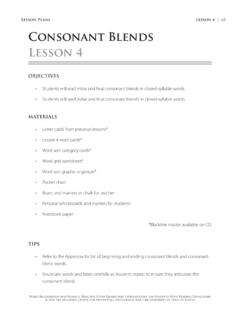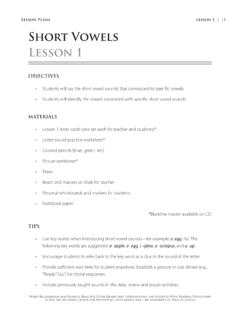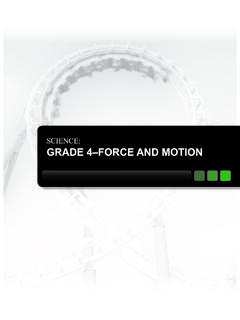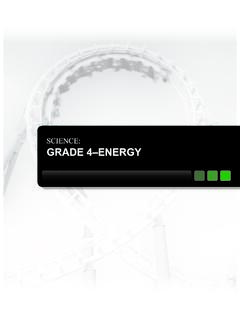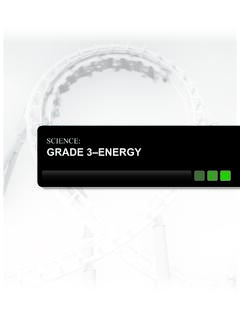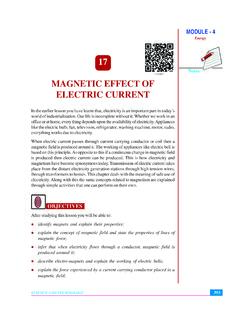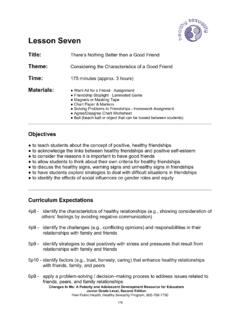Transcription of SCIENCE: GRADE 2–FORCE AND MOTION
1 SCIENCE: GRADE 2 FORCE AND MOTION314 GRADE 2 Force and MotionMagnets in Everyday LifeTEKS2 (6) Force, MOTION , and energy. The student knows that forces cause change and energy exists in many forms. (B) The student is expected to observe and identify how magnets are used in everyday life. ScienceScience Process Skills2 (1) Scientific investigation and reasoning. The student conducts classroom and outdoor investigations following home and school safety procedures.(A) The student is expected to identify and demonstrate safe practices as described in the Texas Safety Standards during classroom and outdoor investigations, including wearing safety goggles, washing hands, and using materials (2) Scientific investigation and reasoning. The student develops abilities necessary to do scientific inquiry in classroom and outdoor investigations.
2 (A) The student is expected to ask questions about organisms, objects, and events during observations and investigations.(B) The student is expected to plan and conduct descriptive investigations such as how organisms grow.(D) The student is expected to record and organize data using pictures, numbers, and (3) Scientific investigation and reasoning. The student knows that information and critical thinking, scientific problem solving, and the contributions of scientists are used in making decisions.(A) The student is expected to identify and explain a problem in his/her own Content ObjectiveI can identify how magnets are used in everyday life. 2012 TEXAS EDUCATION AGENCY. ALL RIGHTS 2 Force and Motionwords and propose a task and solution for the problem such as a lack of water in a habitat.
3 2 (4) Scientific investigation and reasoning. The student uses age-appropriate tools and models to investigate the natural world.(A) The student is expected to collect, record, and compare information using tools, including computers, hand lenses, rulers, primary balances, plastic beakers, magnets, collecting nets, notebooks, and safety goggles; timing devices, including clocks and stopwatches; weather instruments such as thermometers, wind vanes, and rain gauges; and materials to support observations of habitats of organisms such as terrariums and aquariums. 2 (5) Matter and energy. The student knows that matter has physical properties and those properties determine how it is described, classified, changed, and used.(D) The student is expected to combine materials that when put together can do things that they cannot do by themselves such as building a tower or a bridge and justify the selection of those materials based on their physical (13) Underlying processes and mathematical tools.
4 The student communicates about GRADE 2 mathematics using informal language. (A) The student is expected to explain and record observations using objects, words, pictures, numbers, and (14) Underlying processes and mathematical tools. The student uses logical reasoning. The student is expected to justify his or her thinking using objects, words, pictures, numbers, and Language Arts and Reading2 (28) Listening and speaking/listening. Students use comprehension skills to listen attentively to others in formal and informal settings. Students continue to apply earlier standards with greater complexity.(A) Students are expected to listen attentively to speakers and ask relevant questions to clarify 2 Force and Motion2 (29) Listening and speaking/speaking. Students speak clearly and to the point, using the conventions of language.
5 Students continue to apply earlier standards with greater complexity. Students are expected to share information and ideas that focus on the topic under discussion, speaking clearly at an appropriate pace, using the conventions of (30) Listening and speaking/teamwork. Students work productively with others in teams. Students continue to apply earlier standards with greater complexity. Students are expected to follow agreed-upon rules for discussion, including listening to others, speaking when recognized, and making appropriate 19. Reading/comprehension skills. Students use a flexible range of metacognitive reading skills in both assigned and independent reading to understand an author s message. Students will continue to apply earlier standards with greater depth in increasingly more complex texts as they become self-directed, critical readers.
6 (C) The student is expected to monitor and adjust comprehension ( , using background knowledge, creating sensory images, re-reading a portion aloud, generating questions).(D) The student is expected to make inferences about text using textual evidence to support understanding.(F) The student is expected to make connections to own experiences, to ideas in other texts, and to the larger community and discuss textual evidence. 2012 TEXAS EDUCATION AGENCY. ALL RIGHTS 2 Force and MotionEnglish Language Proficiency Standards2 (I) Cross-curricular second language acquisition/listening. The student is expected to demonstrate listening comprehension of increasingly complex spoken English by following directions, retelling or summarizing spoken messages, responding to questions and requests, collaborating with peers, and taking notes commensurate with content and GRADE -level (D) Cross-curricular second language acquisition/speaking.
7 The student is expected to speak using GRADE -level content area vocabulary in context to internalize new English words and build academic language to Intervention/Tier 1 DifferentiationAll science lessons support students in receiving quality Tier 1 instruction. Using the 5E model, knowledge is taught in a variety of contexts, integrating math, science, and ELA content, thus supporting the active engagement of students with the content. lesson -specific differentiation strategies for addressing diverse student needs can be found throughout each lesson in sections titled Differentiation Strategy. Differentiation should focus on skills students did not understand and extend the lesson for advanced students; be conducted in small groups or embedded in whole-group instruction; and provide students with a variety of strategies to process the information, such as -allowing for additional opportunities for verbal brainstorming of words associated with a topic (with teacher taking dictation); -making clear connections of new and more complex concepts to foundational aspects and prior knowledge; -participating in more tangible experiences, such as experiments, investigations, and active exploration; -sorting academic vocabulary words into categories by common attributes process words or science content vocabulary.
8 Language ObjectiveI can follow spoken and written instructions to complete a 2 Force and MOTION -organizing brainstorming into semantic maps or creating graphic organizers; -discussing the meaning of a graphic organizer with a partner; and -creating a visual representation to demonstrate the handout in the Content Resources section that addresses instructional and Career Readiness Collaborative and safe working practices. Collaborate on joint Effective communication of scientific information. Use several modes of expression to describe or characterize natural patterns and phenomena. These modes of expression include narrative, numerical, graphical, pictorial, symbolic, and Focusmagnetsidentifyobserve 2012 TEXAS EDUCATION AGENCY. ALL RIGHTS 2 Force and MotionPrerequisite Science KnowledgeK (6)(B) The student is expected to explore interactions between magnets and various (6)(B) The student is expected to predict and describe how a magnet can be used to push and pull an lesson SummaryEngage Students identify everyday uses of Students explore how magnets are used in everyday Students explain and explore everyday uses of Students identify a problem that could be solved with a magnet and create a Students illustrate how they use magnets every 2 Force and MotionEngageAdvance PreparationGather objects with magnets, such as a purse or a phone case with a magnetic closure, jewelry with a magnetic clasp, refrigerator magnets, a screwdriver with a magnetic tip, and a paper clip StrategyELL.
9 Display the photos from RM 1: Everyday magnet Photos and ask students to use magazines or the Internet to gather additional pictures of everyday objects that use magnets. Students will then create an interactive photo board of magnetic items. Identify each object or photo with a Instruction Display the pictures from RM 1 and the gathered objects for all students to observe. Ask the following: What do all these items have in common? Accept all reasonable answers. Ask the following: Which of these objects have magnets and which do not? Answers will vary based on objects used. Lead students to discover that each object uses magnets in one way or another. At this time, students need to understand only that magnets are used in many ways. Ask the following: Did you know that magnets were used in so many ways?
10 Which of these magnet examples surprised you? Accept all reasonable teacher RM 1, printed in color or projected objects with magnetsVisit Substitute this Glog for RM 1. 2012 TEXAS EDUCATION AGENCY. ALL RIGHTS 2 Force and MotionExploreAdvance PreparationWorld s Simplest Motors can be purchased from educational supply companies or some craft stores. Use the instructions below to partially prepare a World s Simplest Motor for each student group. Then place the motor pieces into a resealable plastic bag for each student group. Straighten the Measure 5 cm from one end of the wire and make a small Put on your safety goggles to protect your eyes from loose Wrap the rest of the wire after the bend around the battery. 4. Leave about 5 cm of wire sticking straight out to match the other end of wire (Figure 1).

